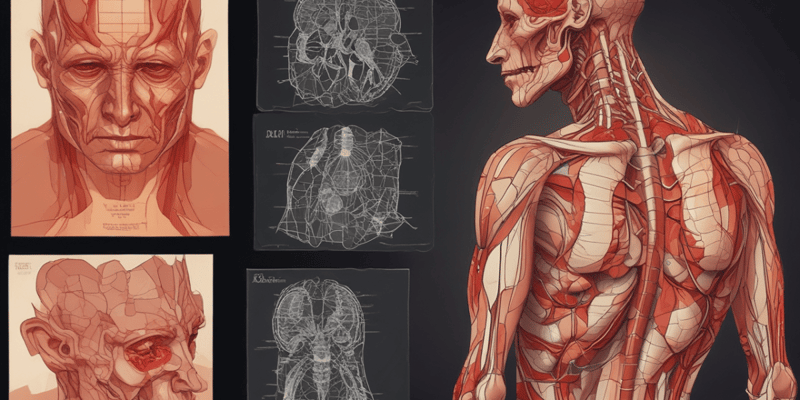Podcast Beta
Questions and Answers
Which type of burn is caused by exposure to heat from any source?
What is one of the first priorities in treating burns?
What can occur when large areas of skin are burned?
Individuals with burns on the face may also have which type of injury?
Signup and view all the answers
When should you consider scene safety before entering an area with burns?
Signup and view all the answers
Which action should be taken if someone is on fire?
Signup and view all the answers
What should you do before treating a patient at the scene of an electrical burn?
Signup and view all the answers
What type of burns can cause skin damage through chemical exposure?
Signup and view all the answers
What is the first step in treating a patient with a thermal burn?
Signup and view all the answers
Which of the following is true regarding superficial burns?
Signup and view all the answers
In treating partial-thickness burns, what should you avoid doing?
Signup and view all the answers
When dealing with a full-thickness burn, what should you do if clothing is stuck to the burn?
Signup and view all the answers
What is a critical priority for patients with inhalation burns?
Signup and view all the answers
Which of the following indicates chemical eye burn treatment should be prioritized?
Signup and view all the answers
What should you do when you arrive at a scene where a patient has been struck by lightning?
Signup and view all the answers
Which symptom could indicate smoke inhalation in a patient?
Signup and view all the answers
What is the first step in treating a chemical skin burn?
Signup and view all the answers
How should you flush a chemical from the eye?
Signup and view all the answers
Which of the following is true about treating a chemical burn?
Signup and view all the answers
What should you do if the patient is unable to remove their clothing during a chemical skin burn treatment?
Signup and view all the answers
What method should be used to determine the path of electricity in an electrical burn?
Signup and view all the answers
What is a critical action to take when treating an electrical burn?
Signup and view all the answers
In the case of both eyes being affected by a chemical, how should you proceed with the flushing?
Signup and view all the answers
What should be avoided while treating a chemical skin burn?
Signup and view all the answers
Study Notes
Burn Injuries: Recognizing and Treating
- Burns in children may indicate abuse; facial, hand, foot, and genital burns are critical injuries.
- Facial burns may accompany inhalation burns; signs include singed hair, burns around orifices, soot, breathing difficulty, and coughing. Swelling can obstruct airways.
- Chest burns restrict breathing. Infection risk increases with burn size.
- Extensive burns cause hypothermia due to impaired thermoregulation. Fluid loss and infection lead to shock.
Burn Types
- Thermal burns: Caused by heat exposure.
- Inhalation burns: Caused by smoke or chemical inhalation.
- Chemical burns: Caused by liquid or dry chemical contact with skin.
- Electrical burns: Caused by electrical current or lightning.
Scene Safety
- Check for explosives before approaching thermal or chemical burn scenes.
- Approach upwind.
- Instruct victims on fire to "stop, drop, and roll," and apply water if possible.
- Avoid active chemical spills.
- Polyester and latex can melt onto skin in fires.
- Ensure electrical safety before treating electrical burn victims; disconnect power if necessary.
- Do not approach lightning strike victims until safe to do so.
Burn Treatments: General Principals
- Do not apply creams (aloe vera, petroleum jelly, butter), bandage fingers/toes together, or directly apply ice.
Thermal Burn Treatment
- Remove from heat source.
- Determine burn depth:
- Superficial: Flush with cool water, cover with sterile dressing.
- Partial-thickness: Flush with cool water (if blisters intact), cover with sterile dressing. Do not puncture blisters.
- Full-thickness: Do not flush with water; leave any embedded clothing in place.
Inhalation Burn Treatment
- Position for comfort.
- Maintain airway; soot around mouth/nose indicates smoke inhalation.
- Smoke inhalation can expose victims to poisonous gases (cyanide, carbon monoxide). Victims may be critically ill even without major burns.
Chemical Eye Burn Treatment
- Position unaffected eye higher than affected eye.
- Gently hold eyelid open while flushing.
- Flush for 20 minutes from inner to outer canthus with clean (non-sterile) water, using fresh water for each flush.
- Flush one eye at a time if both are affected, alternating eye positions.
Chemical Skin Burn Treatment
- Identify the chemical.
- Carefully remove clothing, avoiding spreading the chemical.
- Brush off dry residue.
- Flush with water for at least 20 minutes, keeping unaffected areas elevated.
Electrical Burn Treatment
- Call EMS immediately, even if the patient seems fine.
- Remove clothing (except embedded clothing).
- Note entrance and exit wounds.
- Treat as a thermal burn.
- Be aware of potential spinal injury, cardiac arrest, and internal damage.
Studying That Suits You
Use AI to generate personalized quizzes and flashcards to suit your learning preferences.
Related Documents
Description
This quiz focuses on the identification and treatment of burn injuries, particularly in children, and outlines the various types of burns including thermal, inhalation, chemical, and electrical. You'll learn about critical signs of burn injuries, safety measures at burn scenes, and the risks associated with different types of burns.




